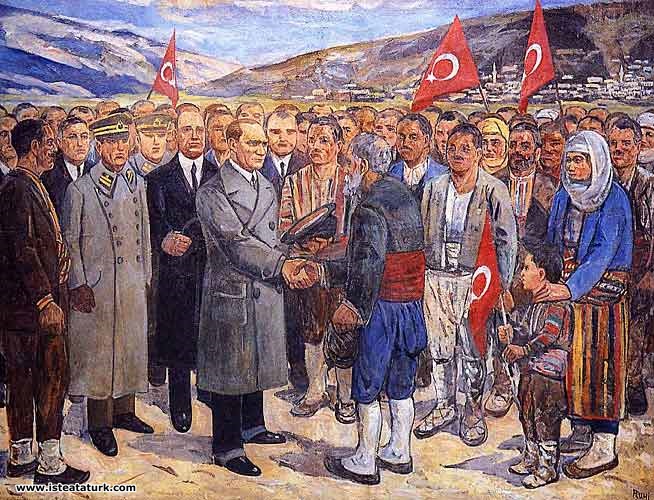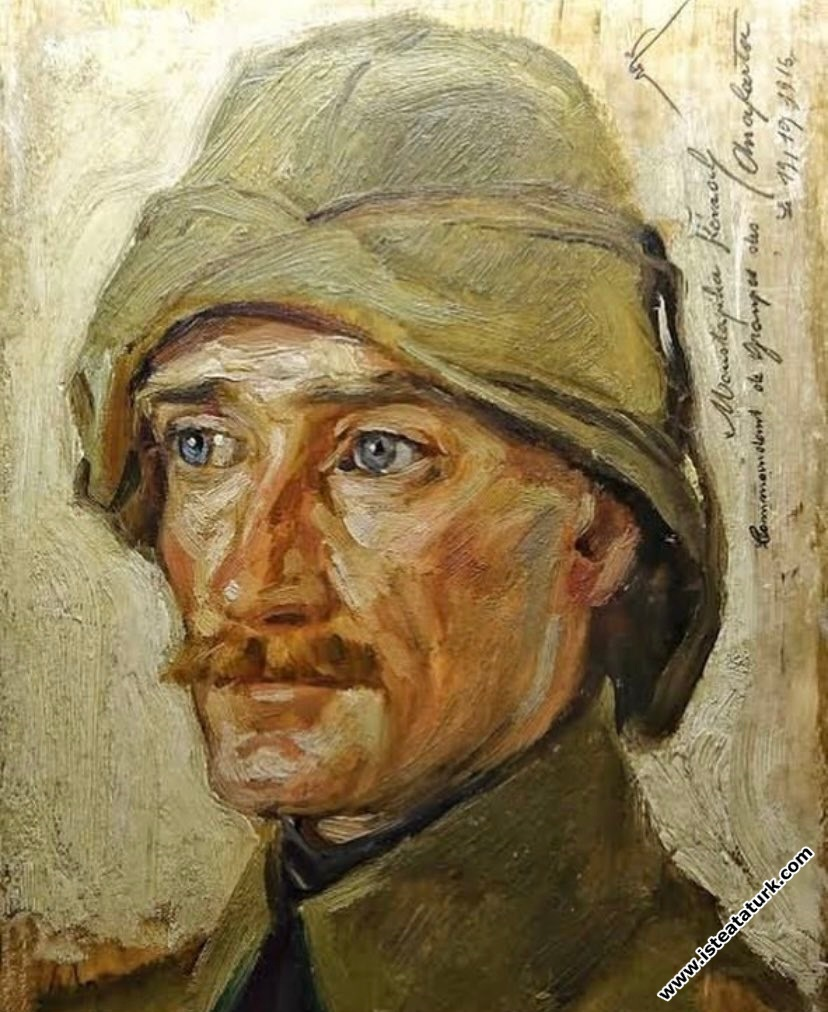
Mehmet Ruhi Arel, Atatürk with the Villagers
Character Size
Atatürk With Villagers, 142 x 185 cm.
Mehmet Ruhi Arel's 142 x 185 cm. sized painting is one of the many paintings that the artist made during this period. In the picture, young, old women and men villagers greet Atatürk with flags in front of their distant village, which comes with a military and civilian crowd. The painting, which does not seem to have many technical problems, is as if the portraits of soldiers, civilians and peasants, all in the same line, are a 'gallery of faces', on which they are especially emphasized.
Mehmet Ruhi Arel (1880 - 1931)
Mehmet Rûhi (Arel) is among the painters of the 1914 Generation and the 4th generation Soldier Painters, who witnessed the disintegration process of the Ottoman Empire and at the same time the Constitutional Monarchy periods, in which the westernization movements gained momentum, and the welcoming of the newly established Republic of Turkey. The year 1908, II. Abdulhamid's dethronement and II. It creates a new turning point with the declaration of the Constitutional Monarchy. In this period, the art comes out of the monopoly of the Palace and the control of the art environment passes to Sanayi-i Nefise-i Mekteb-i Âlisi, an institution that has begun to settle; until 1957, when the Istanbul State Applied Fine Arts School was established. II. After the proclamation of the Constitutional Monarchy, the Ottoman Painters Society was established. II. The Incident of March 31, the Tripoli Wars, on the way from the Constitutional Era to the Republican era, where the foundation of modern Turkey was laid.
Artist, II. He reflects the nationalist views and liberal approaches of the Constitutional Monarchy and later the enthusiasm of the newly established Republic on his canvases. With the proclamation of the Republic, the basic principles of populism, nationalism and the concept of national sovereignty as a result of these became the determinants of culture and art policies. A process is entered in which efforts are made to solve the economic welfare problem that will allow integration in the fields of culture and art. With the beginning of the National Struggle period, painters, architects and sculptors, who saw that the country was aiming for a great change, developed an attitude supporting this struggle. The relationship between Mehmet Rûhi's artistic products and his contemporary background, intellectual movements after the Second Constitutional Monarchy (Ottoman Painters Society and Newspaper,
Mehmet Rûhi's interest in painting begins during his student years at the Naval School. Painting lessons in military schools, as is known, are based on perspective, that is, science teaching. Undoubtedly, the origin of the skillful use of perspective knowledge, which we encounter in “Portrait of his Son Şemsi Arel”, “Leblebici”, “A Zeybek”, “Prayer in the Morning Prayer”, “Kağıthane” and many other paintings, lies here.
The artist then enters Sanayi-i Nefise Mektebi, where he became a student of Salvatore Valeri. It is clear that Valeri is not a very skilled painter. There is only one reason why he teaches at Sanayi-i Nefise, and that is because he prefers to draw figures. Mehmet Rûhi, like the others, becomes a student of Fernand Cormon at the Paris Fine Arts School. Academic painter Cormon, who paints on historical themes, is influential in Mehmet Rûhi's creation of visual documents of contemporary history. Mehmet Rûhi also makes use of the Impressionist technique from time to time. His canvases such as “Portrait of His Wife Muzaffer Hanım”, “Portrait of Mehmet Emin Yurdakul”, “Leblebici”, “Luxembourg Park”, “Erenköy”, “Fatih District Governorship” constitute the main examples in this sense. With the outbreak of the First World War in 1914, Mehmet Rûhi returns home. Çanakkale War in 1915, The year 1916 is reflected in the Galatasaray Exhibition. Positive criticism paves the way for Şişli Atelier, which was established in 1917 at the initiative of Enver Pasha. Mehmet Rûhi, contemporary historical pictures here. These anti-war pictures are undoubtedly for propaganda purposes and are closely related to state policy. Mehmet Rûhi's artistic personality is also revealed in his paintings of this type.
Source: 1- Eczacıbaşı Virtual Museum 2- Figure in Republic Painting with Examples from Some Atatürk Paintings, Assist. Assoc. Dr. Seyfi President, JOURNAL OF ATATÜRK RESEARCH CENTER, Issue 63, Volume: XXI, November 2005
